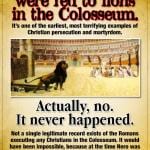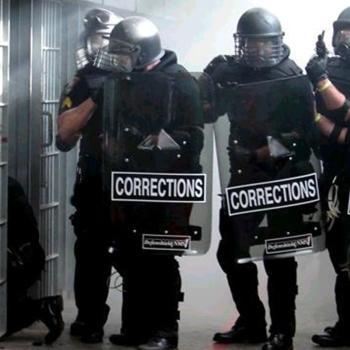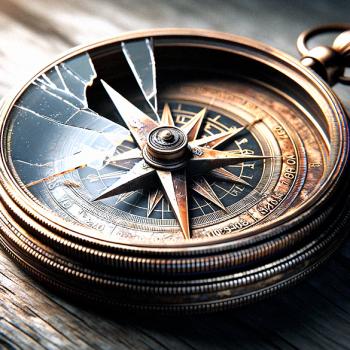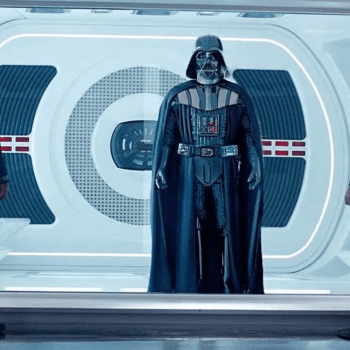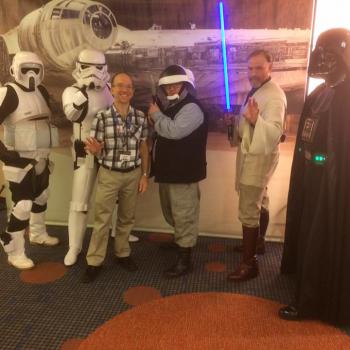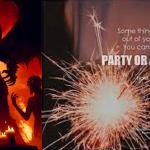I went with my son to see the latest Star Wars film and the last in this trilogy of trilogies, The Rise of Skywalker, as soon as it was in theaters. I will offer a spoiler-free assessment in this first paragraph and so anyone who wishes to know what I think can read it safely and without hesitation. Once the paragraph ends, only those who don’t care about spoilers or who’ve already seen it should continue reading. But I want to offer something first to those who have not seen it, especially since there have been mixed reviews. I can honestly say that it is one of the Star Wars movies that I have found the most thoroughly satisfying immediately after the first viewing. I’d put it up there with the original trilogy, and I highly recommend it. Given the story that had been told in the original trilogy, the prequels, and then most recently the J. J. Abrams/Disney films, I cannot think of a more satisfying way that the major plot elements, character arcs, and overall story trajectories could have been brought to closure and resolution. Even the music seemed perfect, bringing some new offerings that were fantastic while echoing, recapping, and creatively adapting and reworking old familiar themes. I will say a bit more about that in the next paragraph, and so if you’re okay with a “musical spoiler” but not reveals of plot points, you can safely read the next paragraph as well.
As I said, in moving on I will say one thing that I suppose could count as a “musical spoiler” but doesn’t give away any plot elements. It seems good to offer a buffer between the end of that first paragraph and talking about the plot. If the music is a major part of the experience for you, then stop reading now and just experience it. But I have to say this about the movie, which was really musically satisfying. In Episode VII when Rey’s theme was introduced, I thought it was interesting and distinctive, but not as impressive as the themes I associated with other characters. Hearing what Williams does with it in this movie, I think he was deliberately holding back. He may not have already known where Abrams would take Rey’s story. But he gathered that she would be central to the ongoing story, and knew he would need to wow us with music connected with her. He does, and it is brilliant, and I now look back on the restraint with which her theme was introduced and am just simply floored. It takes a combination of genius and determination. It was like composing Anakin’s theme envisaging that part of it can become the Imperial March, except this time working forward chronologically instead of jumping backwards.
Now, to dive into other details, including spoilers. As the opening text scrolled across the screen, I was already struck by word choices that did two things: indicate the resolution of and connection with points all across the story, and connect with religious themes. The dead speak. There is a threat of revenge. The First Order is described as diabolical. Reference is made to the phantom Emperor. Palpatine seems to have returned. We don’t have long to wait until we find out whether this is so or not. Kylo Ren is shown fighting in order to gain possession of an object that we later learn is a Sith wayfinder, which allows him to find his way to a planet that is later revealed to be called Exegol, which is the mythical home of the Sith. We discover that Palpatine has (echoing language used in the prequels) found the Dark Side to be a pathway to abilities that some consider unnatural – allowing him to make Snoke as well as preserve his own life, although his mobility requires mechanical assistance now. A member of the resistance will later refer to “dark science” and in that context mention cloning. Whether Snoke was made in a vat using some of Palpatine’s own genetic material, we aren’t told. Palpatine has been building a fleet there, ready to replace the First Order with the Final Order.
The music often conveys the peace that the Jedi pursue to restore their calm and centeredness to good effect. We see just how powerful Rey is becoming as she levitates, meditating, amid rocks that she is also levitating. She seeks (unsuccessfully at this point) to connect to the Jedi that have come before her. Leia is training her, and she is also studying the Jedi texts that she took from Ahch-To. Among those are notes that allow them to retrace and continue Luke’s quest to find the way to Exegol. That journey leads them to a religious celebration of the ancestors (featuring cute alien children) and assistance from Captain Lando Calrissian. As they flee stormtroopers that can fly, they fall into something like quicksand, except that it is formed from pebbles rather than sand, and they end up in a cavern where the Sith loyalist on whose trail they had been had left behind a dagger with Sith writing on it. I really liked the point that C-3P0 could understand the writing, but because of a law prohibiting the translation of the Sith language his programming prevented him from telling them the meaning. There they also encounter a large snake-like creature, and in one of many wonderful moments in the film, we see Rey heal the creature which had been wounded at some point by transferring some of her life energy to it. Grateful, the creature leaves them in peace and allows them to leave the tunnels. (When they first found themselves in the tunnels, C-3P0 pondered whether they might be in the afterlife, expressing surprise that droids might be allowed to enter that after all. That could be the focus of a blog post in its own right!)
Soon after, Rey and Kylo battle in ways that are impressive. Rey leaps and cuts off the wing of Kylo’s TIE Fighter. They struggle with the Force to pull back or assist the departure of an imperial transport which Chewbacca is believed to be on, having been captured. Rey unintentionally sends out Force lightning, destroying the transport and leaving her afraid of her powers and of herself. She later confides in Finn telling him that that power came from her, she lost control, and that she had a vision of herself sitting on the Sith throne. As they seek the information C-3P0 has but cannot share, they seek out a black market droid specialist named Babu Frik, whose cuteness competes with that of baby Yoda. It seems that a procedure that ultimately results in a memory wipe will be the only way to get at the data. As C-3P0 resists the idea, in another nice throwback to earlier films, Rey tells the droid that he knows the odds better than anyone, and so should decide whether there is another way to proceed.
Mention is made of a battle at which the Resistance called for help but no one came, leading to one of the major elements central to the film’s moral message: they win by making you think you’re alone. That has always been how dictatorships have succeeded for a time, by making people believe that others do not share their desire to rise up and resist, or at least if they share the sentiment, they won’t actually risk their lives to act on the feeling. Moral instinct plays a significant role in the message of the film as well.
The movie has comical elements which seemed to me just the right amount (never distracting from the plot in the way C-3P0 did in the droid factory sequence in Attack of the Clones). I loved for instance when Rey used the force to get stormtroopers to be relieved they were there and help them, and Finn and Poe asked whether she ever used that on them.
The biggest revelation of the movie is arguably that Rey is a Palpatine, the granddaughter of the Emperor, and her parents died to protect her from him. It is also clarified that Rey and Kylo are a dyad in the Force, something of a rarity, connecting them and making them particularly strong together. The way this connection allows them to have a lightsaber duel despite not being in the same location results in some particularly cool moments.
As the dagger’s information leads them to a moon of Endor and the wreckage of the second Death Star, they also find more stormtroopers who deserted. While there, Kylo and Rey fight some more, and Kylo seeks to lure her to accept who she is, and that the dark side is in their nature. Leia senses something, and reaches out to her son. It distracts him, and Rey stabs him – but then heals him using the Force. The effort of reaching out to him leads Leia to die, and that plus the loving memory of his father leads Ben back to embrace the cause that his parents fought for.
Ben tosses away his red lightsaber, while Rey goes to Ahch-To and tosses away the one she had that had been Luke’s. But his force ghost appears and catches it, and he helps Rey to not make the mistake that he had of isolating himself or herself away out of fear of their own shortcomings and potential to do evil. The fact that Leia trained Rey knowing she was a Palpatine helps make the point that Luke articulates by saying that some things are stronger than blood. When Luke raises his old X-Wing from the water, the music from the parallel scene in Empire Strikes Back is perfect. She came in a TIE Fighter, but leaves in an X-Wing. And we later see the X-Wing and Ben’s TIE fighter parked side by side, in another wonderful brief image symbolizing the dyadic balance they’ve found their way to, one by a path of fearing and wrestling with the darkness inside, the other from the opposite direction resisting the light.
The Resistance seeks to stop the fleet on Exegor, to which Rey leads them, having salvaged the Sith wayfinder that had been in Kylo’s TIE Fighter. But they will need help. Rey and eventually also Ben confront Emperor Palpatine, and while at first he tries to lure his granddaughter to sacrifice him so that he and all the Sith can live on in her as Empress, he discovers that he can actually steal healing energy from this Force dyad and so pursues that end. Ultimately Palpatine is finally destroyed by his own Force lightning, as Rey uses two lightsabers to send that energy back onto him. The word sacrifice is in fact the one Palpatine uses, and we also see this is indeed part of a religious ceremony with an audience in bleachers and statues of Sith all around. It is around this time that we get the really impressive treatment of Rey’s theme, so be sure to listen out to it – and indeed, all the music deserves your attention.
The moment when the Resistance fighters are losing hope and the sky can be seen full of ships that have come to assist them is powerful and moving. As an officer on the command star destroyer says, it isn’t a navy – just people.
Rey finally manages to connect with past Jedi, and hears their voices. “Alone, you have never been” says one familiar voice, for instance. The Jedi live on in her, just as the Sith live on in Palpatine, and his father lives on in Ben for that matter. Rey drops to the ground dead once she has defeated her grandfather, but Ben saves her by sharing his own life force, bringing her back from the dead but fading himself to become one with the Force. Leia’s corpse then also vanishes leaving only the shroud that had covered it.
The final celebration with the three friends hugging and crying, and then Rey’s last action in the film, all wrap the story up in a satisfying way. Rey takes Luke’s and Leia’s lightsabers and buries them at the Skywalker homestead on Tatooine. Asked who she is by a woman who isn’t satisfied with the answer “Rey,” Rey glimpses the force ghosts of the Skywalker siblings and chooses to wear their name instead, answering “Rey Skywalker.” The movie thus ends a story of bloodlines strong in the Force with a message that genes may carry certain abilities, but do not determine how you use those abilities.
Rey has a lightsaber in the final scene that I think is significant. I’m not sure if it is supposed to be grey or yellow, but either way it represents the place of balance that she has finally found as a Grey Jedi, a term not used in the movie but appropriate nonetheless. Up until then, some individuals had found moments of balance between the dark and light, but Rey has made that path her own to a greater extent. Whether the lightsaber combines dark and light, or red and blue/green to make a yellowish-orange, the point is conveyed.
Longtime readers will know that I’ve seen this message of balance, akin to Daoism, as the overall theme of Star Wars and the place that its story ought to reach its natural resolution. This grand finale of the Skywalker family saga also provides opportunity to think and reflect seriously on an important topic in our time and probably in any era: how can evil be defeated without those opposing evildoers becoming evil ourselves? Read some of my earlier posts below for more on these topics. But for now, let me just say that I loved the movie, really and truly loved it, and highly recommend it. If you’ve seen it, what did you think? Please share your thoughts in the comments below!
See too:


